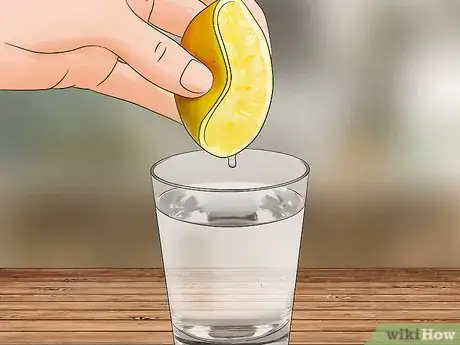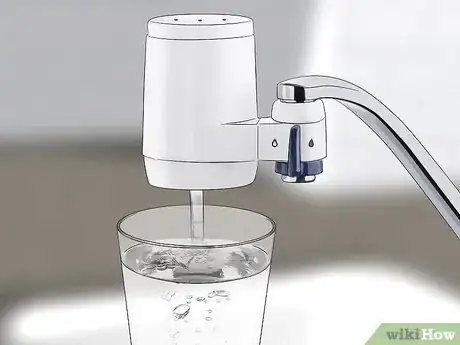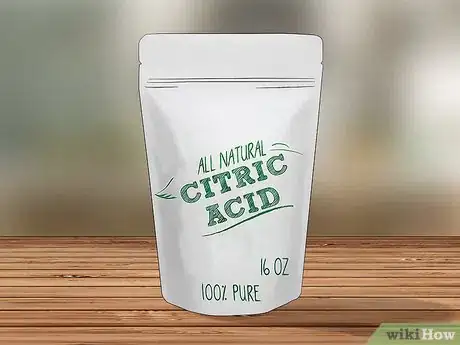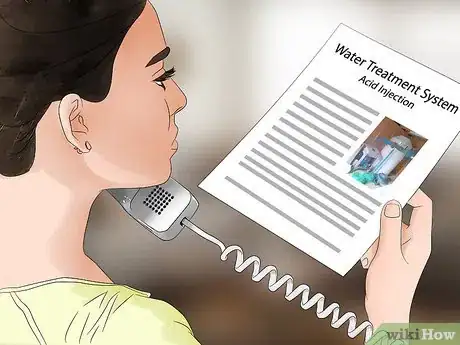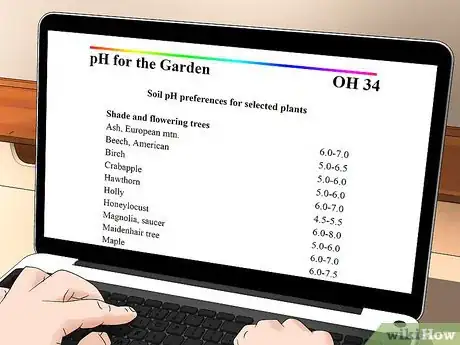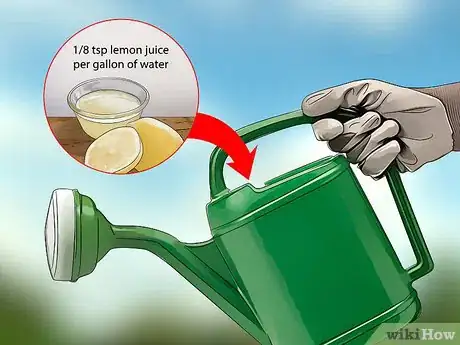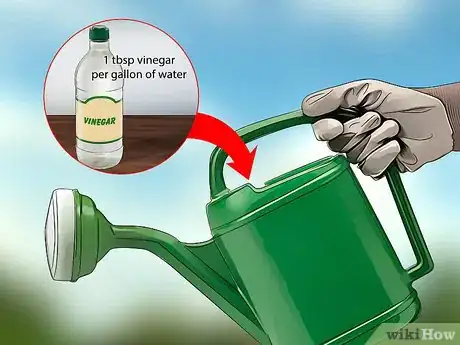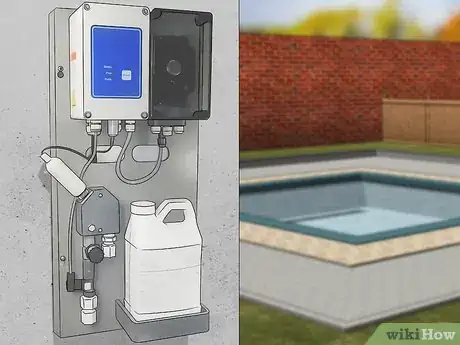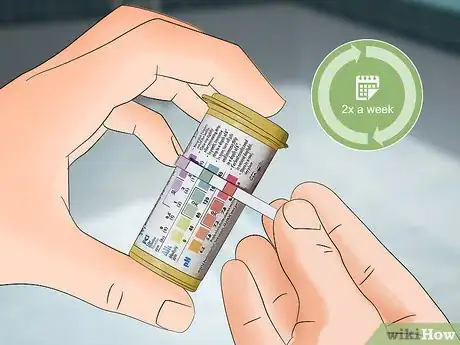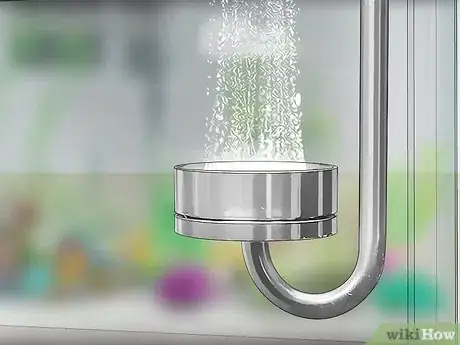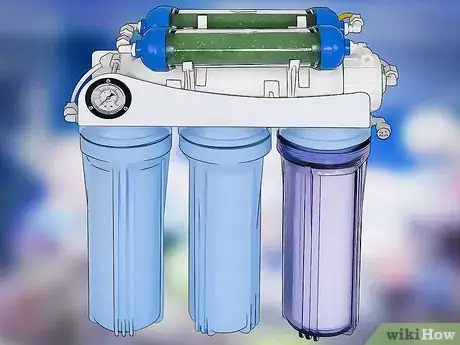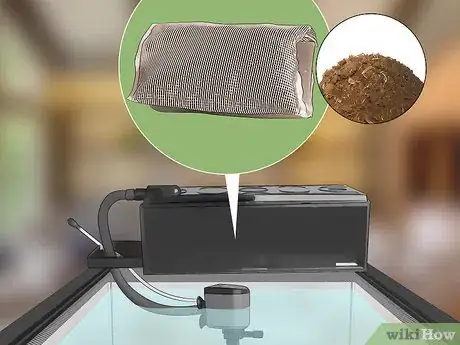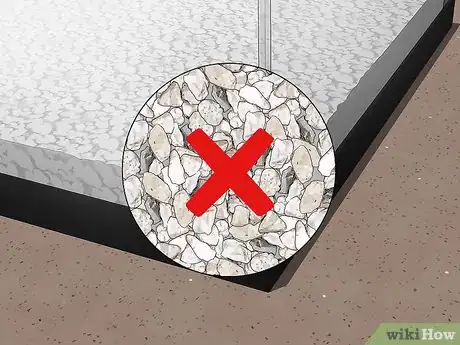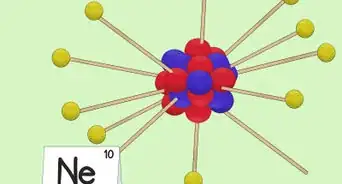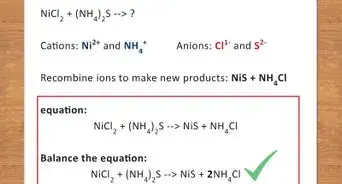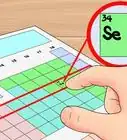This article was co-authored by wikiHow staff writer, Amy Bobinger. Amy Bobinger has been a writer and editor at wikiHow since 2017. She especially enjoys writing articles that help people overcome interpersonal hurdles but frequently covers a variety of subjects, including health and wellness, spirituality, gardening, and more. Amy graduated with a B.A. in English Lit from Mississippi College in 2011 and now lives in her hometown with her husband and two young sons.
There are 12 references cited in this article, which can be found at the bottom of the page.
This article has been viewed 189,356 times.
Learn more...
If you’ve tested your water and it has a high pH, that means that it is too basic, or too alkaline. Water with a high pH can have serious repercussions, whether you’re drinking it or using it in your pool, fish tank, or garden. In your fish tank, for instance, a high pH can make your fish very sick. In your pool, a high pH could irritate your skin and eyes. Luckily, there are ways you can lower the pH of water yourself!
Steps
Drinking Water
-
1Add lemon juice to a glass of water to adjust a single serving. If you don’t want to treat your water at the source and you don’t mind a citrus flavor in your water, drop 2-3 drops of lemon juice to an 8 fl oz (240 mL) glass of water. The lemon will naturally lower the pH of the water by making it more acidic.[1]
- You can also try dropping a lemon wedge in your water if you want a stronger lemon taste.
- Using pure citric acid will have the same effect.
-
2Install a water filter on your tap to lower pH at the source. A water filter works by removing minerals from your water that can raise the pH, including sodium, fluoride, and potassium. Depending on the model you choose, the filter can usually just be screwed onto your faucet. When you turn on the tap, the filter will lower the pH of the water.[2]
- You can find water filters at any home improvement store or supercenter.
- Most household water filters can purify about 10 US gal (38 L) of water every hour.[3]
Advertisement -
3Lower the pH of large amounts of water with food-grade acids. Food-grade preparations of phosphoric, sulfuric, and lactic acids are often used when a recipe, such as a fermentation process, calls for a lower pH. The proportion of these acids to your water will depend on which one you choose and the pH you’re trying to reach, so read the packaging closely.[4]
- These products are often sold where food supply, fermentation, and beer-making supplies are sold.
Did You Know? While it might seem strange to add acids to your water, these leave behind harmless compounds once they're neutralized. Just be sure to read the label and use them correctly!
-
4Install an acid injection system to fix an ongoing problem. An acid injection system balances your water by sensing the pH level where it comes out of the source. It then injects food-grade acids into the flow of the water so it’s balanced when it comes out of the tap. The installation for this type of system is best handled by a professional, so talk to a local water specialist in your area if you’re interested. [5]
- The system and installation can easily be upward of $1500, but if you’re having a problem with high pH in your water, it is an effective fix.[6]
Gardens
-
1Research the water pH needs of the specific plants you're growing. Before you attempt to lower the pH of your water, be sure that your plant prefers an acidic environment. Some plants, such as azaleas and sweet potatoes, prefer more acidity. However, other plants, including wisteria and beets, prefer a neutral or slightly alkaline environment.[7]
- Most plants thrive in a pH range of 5.5-7.0.
-
2Drop lemon juice in your watering can for a natural fix. If you put 1⁄8 tsp (0.62 mL) of lemon juice in 1 US gal (3,800 mL) of water, you can lower the pH by about 1.5 points. The lemon juice can be either freshly-squeezed or bottled, but be sure it's 100% pure.[8]
- You can also use citric acid instead, but you may need to dissolve it in a little water first.
- If you're planning to test the water again, stir in the lemon juice and wait about 5 minutes to ensure it disperses evenly throughout the water.
-
3Add vinegar to the water for an inexpensive fix. Measure 1 US tbsp (15 mL) of plain white vinegar and pour it into 1 US gal (3,800 mL) of water. The natural acidity of the vinegar will help neutralize the alkalinity in the water, bringing a pH of 7.5-7.7 down to about 5.8-6.0.[9]
- Vinegar has a pH of 2-3 and lemon juice has a pH of 2, so their effect on water is similar.[10]
Pools
-
1Add muriatic acid for a quick adjustment in your pool. Muriatic acid, or hydrochloric acid, is commonly used in pools to lower the pH. Depending on the preparation you choose, you’ll either add the acid directly to the pool or dilute it in a bucket of water, then pour into the pool. When you pour in the muriatic acid, hold the container close to the surface of the water so it doesn't splash back onto you. Also, pour the acid directly over a return jet so it will circulate through the water more quickly, and make sure the vent on the return jet is pointing down, if you have one.[11]
- You can buy muriatic acid wherever pool supplies are sold.
- Read the label carefully to determine how much muriatic acid to add to your pool.
- Add a little less than you think you need, wait 4 hours, and test again. Add more if needed.
Warning: Muriatic acid and sodium bisulfate are both corrosive chemicals. Read and follow the label instructions carefully. Work in a ventilated area, and wear eye protection and gloves. After you add the muriatic acid, wait at least 4 hours before you allow anyone into the pool.
-
2Opt for sodium bisulfate for a gentler solution. Sodium bisulfate often comes in granulated form, and depending on the manufacturer’s instructions, you either add them directly to the water, or dissolve them in a bucket then pour them into the pool. Sodium bisulfate helps stabilize your pool’s pH after it’s lowered, so it may be a better option for long-term maintenance.[12]
- While it’s still a dangerous chemical, sodium bisulfate isn’t as harsh as muriatic acid. However, it may not work as quickly, and often lowers the total alkalinity (TA) of your pool more than you may want.
- Use the packaging and your pH readings to determine how much sodium bisulfate to add to your pool.
- Sodium bisulfate is also found wherever you buy your pool supplies.
-
3Install a CO2 system in your pool for long-term balancing. Some CO2 systems are fully-automated, which means that the system will monitor the pH levels in your pool and will add CO2 to lower the pH as needed. Others are controlled manually, so you will need to check the levels daily and adjust the flow of CO2 as needed. To determine which one is right for you, talk to a pool specialist in your area. [13]
- These systems range from $300 to over $10,000, depending on the features you want, but it could save you money if you’re spending a lot on chemicals to balance your pH.
-
4Test the pH at least twice a week with a test kit. The chemicals used in your pool will become unbalanced if they’re left unattended, so it’s important to test the pH in your pool about 2-3 times a week, even after you balance it. You can use litmus test strips if you like, but a DPD test kit will give you more accurate results. These kits measure the pH and total alkalinity (TA) of the water, along with the pool's chlorine levels, making it easier to balance your pool all at once.[14]
- Oils from skin, sunscreen, lotion, and dirt can all change the pH balance in your pool. If your pool is being used every day, you probably need to check it daily.
- You can find these test kits wherever pool supplies are sold.
Aquariums
-
1Install a CO2 bubbler to temporarily lower the pH in an aquarium. Adding a CO2 bubbler to your tank can gently lower the pH, and it works quickly, so it’s a good option if your pH has spiked suddenly. However, CO2 is expensive, and the pH will go back up as soon as the CO2 is gone, so it’s not a good long-term solution.[15]
- You can find CO2 for a tank at a store that specializes in tank supplies.
Warning: Adjusting the pH of your fish tank too rapidly could shock your fish. To avoid this, remove the fish from the aquarium before you try to lower the pH.
-
2Try a reverse osmosis filter for a large fish tank. A reverse osmosis filter is an extremely efficient filter that removes up to 99% of contaminants from water while leaving the ions that make fish healthy. Since the contaminants are what raise the water pH, the filter will naturally lower the pH level as it cleans the water[16]
- These filters can cost upward of $50, and they take up a lot of space, so they’re best for larger tanks.
-
3Place driftwood in your fish tank for natural filtration and decoration. In addition to looking great in a fish tank, driftwood naturally filters the water in your tank. Even a small piece of natural driftwood will lower the pH in your tank, and will also help stabilize it. In addition, the wood will give your fish a new place to explore.
- Driftwood can sometimes discolor the water in your tank. To avoid this, soak the wood in a bucket of water for several days before adding it to your tank.
- Do not use driftwood intended for reptile tanks in a fish tank. It may have been soaked in chemicals that could leak into the water and harm your fish.
- Even a small piece of driftwood will help filter the water in the tank, so pick one that looks like it fits naturally in with your decor.
-
4Add peat moss to your filter for another natural boost. Since peat moss can clump together and might get removed when you’re cleaning your tank, it’s best to put it inside of a mesh bag, then place the bag inside of your filter. The peat moss will naturally assist your filter, helping lower the pH in the tank. Use the size of your filter to help you determine how much of the moss you need to use.[17]
- Peat moss is also prone to discoloring the water in your tank. To avoid this, soak it for a few days in a bucket of water before placing it in your tank.
- The amount of peat moss you should use will depend on the size of your tank and the pH level you’re trying to reach. Experiment with different amounts to find what works for your tank.
- You can buy peat moss online or where fish tank supplies are sold.
-
5Drop 2-3 Catappa leaves into your tank for a pretty, simple fix. The leaves of the Catappa tree, or the Indian almond tree, contain certain chemicals that help filter contaminants from your water. Not only will this help lower the pH of the water to a more stable level, but these chemicals may prevent or even cure some fish diseases, so the leaves could make your fish healthier![18]
- The tannins in the Catappa leaves may slightly change the color of the water, but it won’t be as noticeable as using peat moss or driftwood
-
6Remove crushed coral from your tank if you have any. If you’re having trouble with a high pH level in your tank, your substrate could be to blame. While it looks great in a tank, crushed coral can actually raise the pH level of the water, so you should only use it if you have fish who prefer a more alkaline environment.
Community Q&A
-
QuestionHow do I lower the pH in my water naturally?
 Drew Hawkins1Community AnswerA simple way to lower the pH in your water naturally is to use lemon juice. Simply drop 2-3 drops of lemon juice to an 8 fl oz (240 mL) glass of water. The acidity of a lemon naturally lowers the pH level of the glass of water. You could also just drop a lemon wedge into your water to give a stronger flavor and lower the pH. Lemon juice from a bottle works just as well, too.
Drew Hawkins1Community AnswerA simple way to lower the pH in your water naturally is to use lemon juice. Simply drop 2-3 drops of lemon juice to an 8 fl oz (240 mL) glass of water. The acidity of a lemon naturally lowers the pH level of the glass of water. You could also just drop a lemon wedge into your water to give a stronger flavor and lower the pH. Lemon juice from a bottle works just as well, too. -
QuestionWhat can I use to lower pH in water?
 Drew Hawkins1Community AnswerThere are a couple of ways you can lower pH in water. If you're drinking a glass of water, add a few drops of lemon juice. The acidity will lower the pH naturally. You could also install an acid injection system to your water supply to lower the pH of your drinking water. If you're trying to lower the pH of the water for your plants, you can add vinegar for a quick and cheap fix. Measure 1 US tbsp (15 mL) of plain white vinegar and pour it into 1 US gal (3,800 mL) of water. The natural acidity of the vinegar will help neutralize the alkalinity in the water, bringing a pH of 7.5-7.7 down to about 5.8-6.0. For a swimming pool, you'll need to add an industrial acid like muriatic acid and test the pH level to get it where you want it to be.
Drew Hawkins1Community AnswerThere are a couple of ways you can lower pH in water. If you're drinking a glass of water, add a few drops of lemon juice. The acidity will lower the pH naturally. You could also install an acid injection system to your water supply to lower the pH of your drinking water. If you're trying to lower the pH of the water for your plants, you can add vinegar for a quick and cheap fix. Measure 1 US tbsp (15 mL) of plain white vinegar and pour it into 1 US gal (3,800 mL) of water. The natural acidity of the vinegar will help neutralize the alkalinity in the water, bringing a pH of 7.5-7.7 down to about 5.8-6.0. For a swimming pool, you'll need to add an industrial acid like muriatic acid and test the pH level to get it where you want it to be. -
QuestionCan vinegar lower pH?
 Drew Hawkins1Community AnswerYes, vinegar is a cheap and easy way to lower the pH of water. However, it will alter the taste and smell of the water, so you may not want to add vinegar to your drinking water. But, it's a great way to lower the pH of water you plan to use to water your garden. Add 1 US tbsp (15 mL) of plain white vinegar to 1 US gal (3,800 mL) of water to bring down the pH level.
Drew Hawkins1Community AnswerYes, vinegar is a cheap and easy way to lower the pH of water. However, it will alter the taste and smell of the water, so you may not want to add vinegar to your drinking water. But, it's a great way to lower the pH of water you plan to use to water your garden. Add 1 US tbsp (15 mL) of plain white vinegar to 1 US gal (3,800 mL) of water to bring down the pH level.
References
- ↑ https://www.scientificamerican.com/article/bring-science-home-cabbage-chemistry/
- ↑ https://www.watersystemscouncil.org/download/wellcare_information_sheets/potential_groundwater_contaminant_information_sheets/9709284pH_Update_September_2007.pdf
- ↑ https://sciencing.com/reduce-ph-water-5328522.html
- ↑ https://www.canada.ca/en/health-canada/services/food-nutrition/food-safety/food-additives/lists-permitted/10-adjusting-agents.html
- ↑ https://articles.extension.org/pages/32302/drinking-water-treatment-ph-adjustment
- ↑ https://www.watersystemscouncil.org/download/wellcare_information_sheets/potential_groundwater_contaminant_information_sheets/9709284pH_Update_September_2007.pdf
- ↑ http://pss.uvm.edu/ppp/pubs/oh34.htm
- ↑ https://www.scientificamerican.com/article/bring-science-home-cabbage-chemistry/
- ↑ https://van.physics.illinois.edu/qa/listing.php?id=28840
- ↑ https://van.physics.illinois.edu/qa/listing.php?id=28840
- ↑ https://www.in.gov/isdh/files/Chemical_adjustment_pool.pdf
- ↑ https://www.in.gov/isdh/files/Chemical_adjustment_pool.pdf
- ↑ https://www.pwtag.org/carbon-dioxide-for-ph-control-august-2011/
- ↑ https://www.cdc.gov/healthywater/swimming/residential/disinfection-testing.html
- ↑ https://sciencing.com/reduce-ph-water-5328522.html
- ↑ https://www.canr.msu.edu/news/water_alkalinity_and_ph_what_they_mean_in_regards_to_water_quality
- ↑ https://hortnews.extension.iastate.edu/2016/02-12/soilpH.htm
- ↑ https://hortnews.extension.iastate.edu/2016/02-12/soilpH.htm
About This Article
The best way to lower the pH of water depends on what you’re using it for. For drinking water, add 2-3 drops of lemon juice to your glass to lower the pH of a single serving, or install a water filter on your tap to the lower the pH at the source. For houseplant or gardening water, mix 1 tablespoon (15 mL) of white vinegar with 1 gallon (4 liters) of water, which can help bring a pH of 7.5-7.7 down to around 5.8-6.0. To lower the pH in an aquarium, place a piece of driftwood in it, which will naturally lower the pH level. You can also drop 2-3 Catappa leaves into the tank for similar results. If you have a large tank, install a reverse osmosis filter which will filter out contaminants that raise pH. To lower the pH of pool water, add muriatic acid or sodium bisulfate. Another option is to install a CO2 system in your pool, which will monitor and adjust the pH level as needed. To learn how to adjust the pH in a fish tank, read on!
